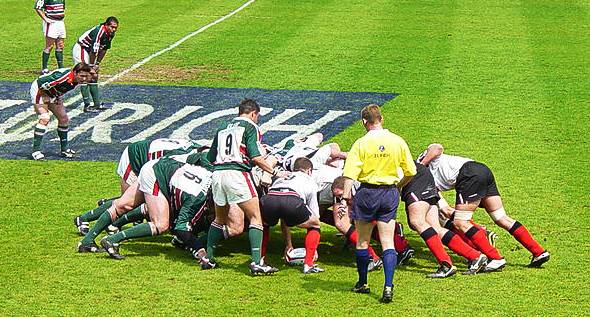The rugby season is nearly over. If you’ve been lucky enough to remain injury free so far, I’d wager you’re being held together by physio tape and painkillers. My hat goes off to you if you are still going strong. It’s a rare thing at this time of the year for rugby players.
The rugby season is nearly over. If you’ve been lucky enough to remain injury free so far, I’d wager you’re being held together by physio tape and painkillers. My hat goes off to you if you are still going strong. It’s a rare thing at this time of the year for rugby players.
We’ve already covered the fundamentals of how to gain strength and develop your conditioning during the rugby season. Now it’s time to look at how to remain fit and free from injury year-round. In this article, I’m going to give you some information on injury prevention and some exercises to get you started.
The best way to prevent injury is to add two types of exercise into your programme: mobility work, and prehabilitation training. Let’s take a look at mobility work first.
Mobility work challenges your range of motion and prepares you for the positions you’ll be pushed into on game day.
Mobility: More Than Just Foam Rolling
Mobility work is becoming increasingly popular to improve your movement, and thankfully so. But this doesn’t mean just doing some soft tissue work on a foam roller. Good mobility work means getting warm and moving through your full range of motion on a regular basis. You need to challenge your body’s existing range to decrease the chance of being tackled or pushed into a compromising position that’ll hurt you on the pitch.
The Ready For Rugby Mobility Warm-Up
I’ve put together the routine below to help you improve your mobility, movement quality, and range of motion. These movements focus on key problem areas for rugby players such as the hamstrings, hips, shoulders, and trunk. Use this routine to warm up before you train. Watch the video demonstrations if you’re unsure of any of the movements.
The Routine:
To begin with, jump on a watt bike/rower/treadmill for around 500m at a comfortable pace or around 50-60% of a maximal effort.
- 5 Bodyweight Squats
- 5 Pogo Jumps
- 5 Reverse Lunge with Overhead Reach (each side)
- 5 Sectional Spine Rollouts Into Hand Walkouts with Push Up
- 10m Bear Crawl
- 5 Full Arm Plank Shoulder Touches (each side)
- 5 Mountain Climber with Trunk Rotation (each side)
- 5 Downward Facing Dog into Vinyasa Sweep
- 5 TRX Row
Bodyweight Squats
- Make sure your knees track over your toes.
- Maintain an upright torso.
- Keep your weight on your heels.
Pogo Jumps
- Rock back on your heels, allowing your toes to raise.
- Roll forwards onto your toes and spring into the air.
- Point your toes at the top of each repetition.
Reverse Lunge with Overhead Reach
- Keep a wide base with your toes tracking forward.
- Perform a deep lunge with your knee close to, but not actually touching, the floor.
- Reach both arms overhead and arch your back, keeping your head through your shoulders.
Sectional Spine Roll into Hand Walkouts with Push Up
- Focus on rolling your spine down section by section, slowly and with control.
- Reach your hands to the floor.
- Perform a controlled walk out.
- Maintain a strong posture in the push up.
Continue to Page 2 for More Ready For Rugby Mobility Exercises
Bear Crawl
- Maintain a flat back throughout to control your spinal position.
- Bring your knees up close to your body.
- Keep your weight shifted over your hands.
Full Arm Plank Shoulder Touches
- Maintain a strong torso with minimal rocking.
- Slowly raise your hand to the opposite shoulder, then replace it to the ground.
- Repeat on the other side.
Mountain Climber with Rotation
- Bring your foot to the side of your hand.
- Turn your torso over your raised knee.
- Follow your hand with your head.
- Keep the movement slow and controlled.
Down Dog into Vinyasa Sweep
- At the top of the down dog, keep your legs straight and your head through your shoulders.
- Perform a controlled sweep through, ensuring your elbows stay tight against your lats.
- Sweep your body up, keeping your hips close to the ground.
TRX Row
- Maintain a strong torso position throughout the row.
- Pinch your shoulder blades together and pull your elbows behind your body.
Continue to Page 3 for the Ready For Rugby Prehabilitation Routine and Exercises
Prehabilitation Prevents Rehabilitation
Prehabilitation exercises, often shortened to “prehab”, are movements used to strengthen potential problem areas. In rugby this is most notably the neck, shoulders, hips, and glutes. Prehab is used to limit the likelihood of injury and negate the need for rehab – hence the name. These exercises are worth their weight in gold for any rugby player, but they’re often overlooked because they aren’t very glamorous and won’t get him or her a ton of new followers on Instagram.

Prehabilitation work prepares and strengthens your body to deal with the hard hits.
My favourite prehab exercises use bands for glute and shoulder activation. The glutes are where rugby players generate much of their power, so keeping them firing with these bands improves power output and avoids some of the issues players can experience in this area. Similarly, we can protect the highly stressed rotator cuff by strengthening its muscles with band work.
The Ready For Rugby Prehab Routine
I’ve given four prehabilitation drills below. Do these movements after your mobility warm-up to avoid injury and keep out of the physio room.
The Routine:
To be completed after The Ready for Rugby Mobility Warm-Up
- 3 x 20 Glute Band Diagonal Walks
- 3 x 12 Glute Clock Faces with Band (each side)
- 3 x 12 Shoulder Clock Faces with Band (each side)
- 3 x 12 Band External Rotation (each side)
Prehabilitation Exercises for Injury Prevention: Glute Band Diagonal Walks
- Take a semi-squat stance with an upright torso.
- Sweep your leg inwards to outwards, keeping your knees tracking over your toes.
- Perform 3 sets of 20 steps: 10 forward, and 10 backward.
Prehabilitation Exercises for Injury Prevention: Glute Clock Faces with Band
- Take a semi-squat stance with an upright torso.
- Perform each rep slowly and with control.
- Push your knees out over your toes – don’t allow them to collapse inward.
- Perform 3 sets of 12 steps each side: 1 forwards, 1 to the side, and 1 backwards.
- Repeat four times on each side.
Prehabilitation Exercises for Injury Prevention: Shoulder Clock Faces with Band
- Start on all fours, with your knees and hands on the floor.
- Maintain a neutral spine.
- Keep tension on the band throughout the movement.
- Make sure your weight stays over your grounded hand.
- 3 sets of 12 hand placements each side: 1 forwards, 1 to the side, and 1 backwards.
- Repeat four times on each side.
Prehabilitation Exercises for Injury Prevention: Band External Rotation
- Keep your elbows bent at a 45-degree angle.
- Keep your elbows tucked in close to your lats.
- Rotate at the shoulder, bringing your hand away from your body.
- Perform each rep slowly and with control.
Injury Prevention Is A Year-Round Commitment
Injury prevention shouldn’t just be addressed toward the end of the year to keep you fit for your last few games. It’s something you should focus on throughout the season and off-season too. Freak injuries can still happen regardless, but you can have more power over their incidence by strengthening your problem areas and keeping your joints and muscles healthy with injury prevention work. The exercises given here are designed to do just that. They’ll keep your body mobile, resilient, and fully prepared, right up to the last game of the season.
More Like This:
- Ready for Rugby: A 4-Week In-Season Fitness Programme
- Ready for Rugby: A 4-Week In-Season Strength Programme
- Build 360-Degree Strength: Rotational Exercises for All Sports
- New on Pulse Beat Fit
Photos courtesy of Wikimedia Commons.






